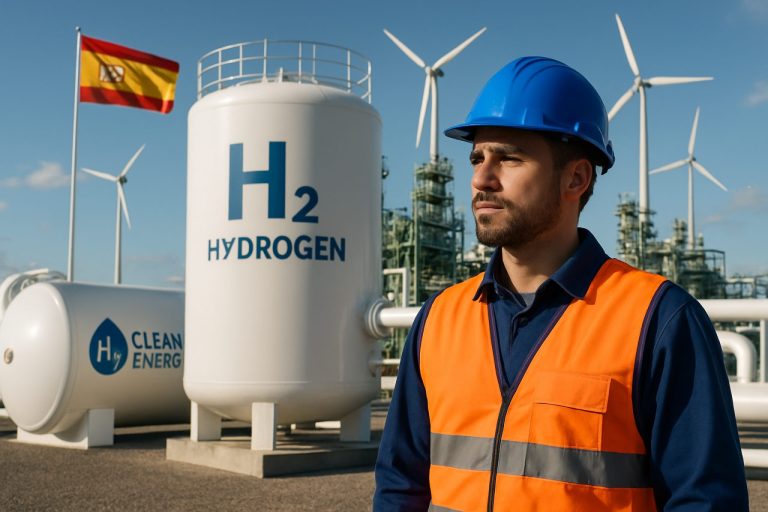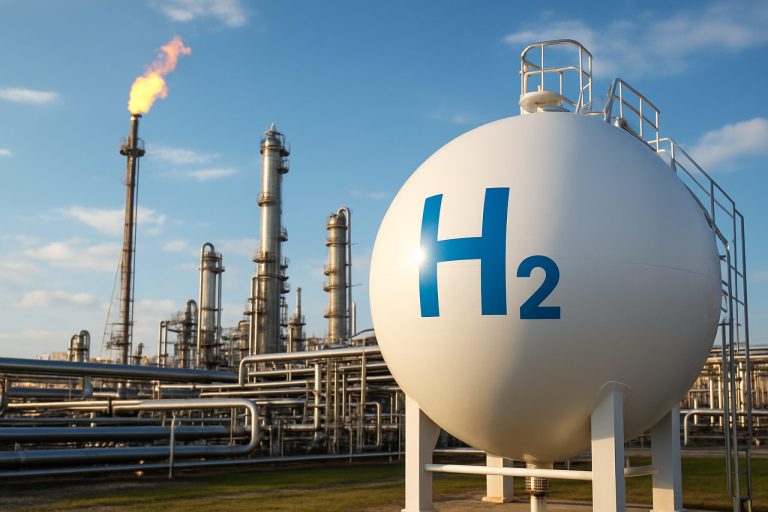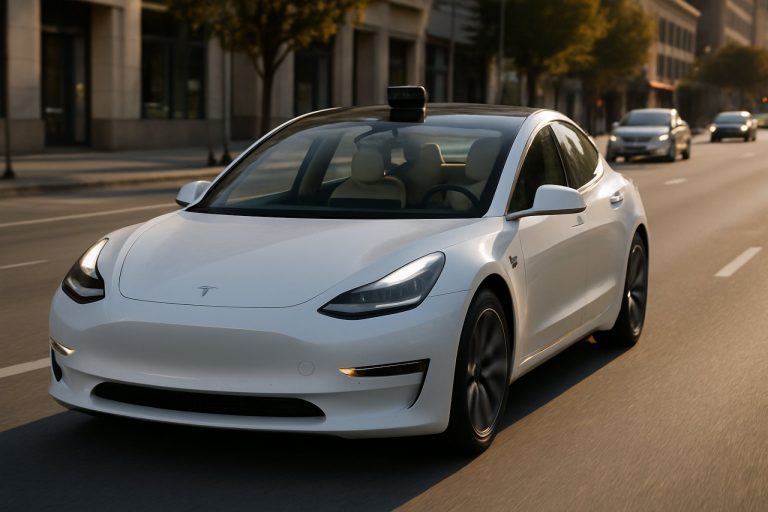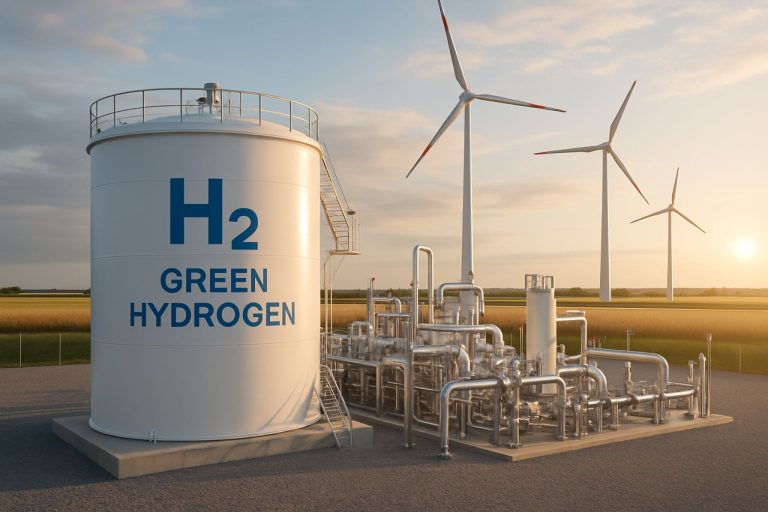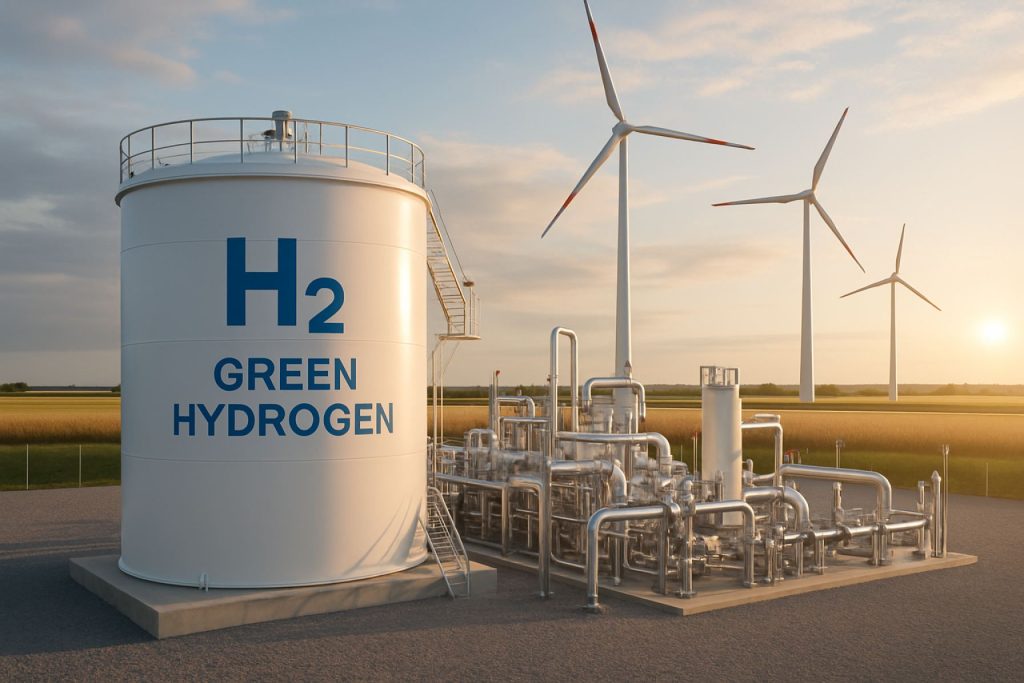
- OMV plans to build a major green hydrogen facility in Austria, aiming for a 140-megawatt capacity and 23,000 tonnes of annual hydrogen production.
- The green hydrogen will replace fossil-fuel-based hydrogen at OMV’s Schwechat refinery, targeting a reduction of 150,000 tonnes of CO2 emissions per year—comparable to taking 65,000 cars off the road.
- The project’s success depends on financial support from EU and Austrian government funds, highlighting the importance of policy and investment in clean energy innovation.
- This initiative positions Austria as a pioneer in Europe’s shift toward climate neutrality, demonstrating the crucial role of hydrogen in decarbonizing heavy industry and supporting energy security.
- OMV’s move symbolizes growing momentum across Europe for large-scale, renewable-powered hydrogen projects within sustainable energy transitions.
In the Austrian plains southeast of Vienna, where wind turbines slice open the horizon and the sun reverberates off sprawling fields, a quiet revolution is underway. Here, OMV—Austria’s energy behemoth—has unveiled plans for a sprawling green hydrogen facility, setting the stage for one of Europe’s most ambitious clean energy transformations.
Overshadowing the modest town of Bruck an der Leitha, the forthcoming plant promises not just local change but a seismic leap for the continent’s energy landscape. With its projected 140 megawatts of capacity, the plant will churn out 23,000 tonnes of hydrogen every year—enough to charge up industry giants and carve away at Austria’s carbon footprint.
The stakes are high. OMV’s Schwechat refinery, one of the largest in Europe, traditionally relies on hydrogen extracted from fossil fuels—a legacy practice that emits vast quantities of carbon dioxide. This green hydrogen, harvested using renewable power sources—a symphony of wind, hydro, and solar—will serve as a direct substitute, setting up an audacious goal: slashing carbon emissions by a staggering 150,000 tonnes annually. That’s the equivalent of pulling some 65,000 cars off the road each year.
But ambition alone doesn’t power innovation. OMV’s final decision is laced with caution. Executives say the project hinges on substantial backing from EU or Austrian government funds—a reminder that, for heavy industry, decarbonization still finds itself at the mercy of policy and financial frameworks. The plant’s anticipated launch in late 2027 reflects both the technological complexity and the regulatory rigors that shape such transformative undertakings.
Europe stands at an energy crossroads. As governments tighten carbon targets and Russia’s war in Ukraine reshapes supply lines, hydrogen—especially the green variety—has surged from obscurity into the mainstream. For Austria, and for OMV, investing in hydrogen isn’t just about compliance. It’s a bid to future-proof the national economy, insulate against fossil fuel volatility, and claim a leading position in the European Union’s race toward climate neutrality.
OMV’s vision does not operate in a vacuum. Across the continent, hydrogen projects are sprouting in Germany, Spain, and France. Yet it’s the scale and urgency of Austria’s plan—coalescing renewable energy, industrial legacy, and political will—that could set a new benchmark. If all goes as planned, this shimmering green complex may soon stand as a symbol of Europe’s energy aspirations, merging hard-nosed pragmatism with a rare, electrifying optimism.
The takeaway? As OMV shapes the contours of tomorrow’s energy sector, Austria underscores a crucial message: the climate crisis demands bold moves, and green hydrogen—long touted as theoretical—might finally claim its place as the engine of the industrial future. To keep pace, the world will be watching, and, perhaps, following Austria’s lead.
For readers seeking more on global and regional innovation in sustainable energy, explore OMV and learn about the company driving these changes.
Europe’s Green Hydrogen Revolution: Austria’s OMV Facility Could Change Everything — What You Need to Know, Insights and Fast Facts Inside
—
Austria’s Massive Leap into Green Hydrogen: Beyond the Headlines
OMV’s ambitious green hydrogen plant in Bruck an der Leitha isn’t just a monumental step for Austria’s clean energy—it’s potentially a gamechanger for all of Europe’s industrial future. Here’s what you need to know that wasn’t fully covered in the original article, plus actionable analysis, real-world implications, and your top questions answered.
—
What Makes OMV’s Green Hydrogen Facility Unique?
Capacity & Output in Context:
– 140 MW Capacity: This places the facility among Europe’s largest planned electrolyzers. Comparable projects are rare—Shell’s REFHYNE plant in Germany currently operates at only 10 MW, showing just how transformative OMV’s scale is ([IEA](https://www.iea.org)).
– 23,000 Tonnes/Year Output: That amount of green hydrogen can fuel over 200,000 fuel cell vehicles annually or supply heavy industry processes (steelmaking, chemical synthesis) that traditionally rely on high-emission gray hydrogen.
Features, Specs & Pricing
– Technology: Likely to use Proton Exchange Membrane (PEM) or Alkaline Electrolysis, both of which efficiently split water into hydrogen and oxygen using renewables.
– Energy Inputs: Solar, wind, and hydroelectricity—leveraging Austria’s renewable grid.
– Pricing: As of 2024, green hydrogen costs range between $3–7 per kilogram, but aggressive scaling and EU subsidies may push OMV’s production to the lower end (~$3/kg within the decade) ([Hydrogen Council](https://hydrogencouncil.com)).
—
How-To: What Will Green Hydrogen Do For Austria and Beyond?
Real-World Use Cases
1. Decarbonizing Heavy Industry: Replaces fossil-derived hydrogen in refineries and ammonia production (key for fertilizers).
2. Transportation Fuel: Enables emissions-free trucks, buses, and trains—vital for progressing beyond electric-only solutions.
3. Grid Balancing: Hydrogen acts as energy storage, crucial for stabilizing power supplies from intermittent sources like wind and solar.
How-To Steps to Adopt Green Hydrogen (Business/Industry):
1. Assess Your Hydrogen Needs: Determine current consumption—gray hydrogen can often be directly replaced by green.
2. Collaborate with Suppliers: OMV and similar leaders announce offtaker agreements years in advance. Early negotiation is key.
3. Plan Infrastructure: Retrofitting storage, piping, and safety systems is essential.
4. Monitor EU Grants: The European Green Deal and Horizon Europe regularly fund hydrogen transitions.
—
Green Hydrogen Market Forecast & Industry Trends
– EU Climate Mandates: The European Union’s “Fit for 55” targets aim for a 55% reduction in greenhouse gases by 2030—hydrogen is central ([European Commission](https://www.europa.eu)).
– Projected Growth: The global green hydrogen market could exceed $80 billion by 2030, with annual capacity growth above 50%.
– Cluster Projects: Hydrogen valleys (integrated value chains) are emerging in Germany, Netherlands, Spain, and France. Austria’s project could anchor a Central European hydrogen hub.
—
Pressing Reader Q&A
Will Omv’s Plant Make Hydrogen Affordable for Everyday Use?
While prices are falling, initial green hydrogen will mainly serve industry where cost parity with gray hydrogen is achievable via subsidies/carbon credits. Consumer-level applications (e.g., home heating, personal vehicles) are likely 5–10 years away from mass competitiveness.
What About Supply Security?
Unlike fossil gas, green hydrogen is made domestically—hugely reducing vulnerability to international supply shocks such as those created by the Ukraine war.
What’s Holding Back Green Hydrogen?
– Cost: Still higher than fossil alternatives without subsidies.
– Infrastructure: Large-scale transport pipelines and refueling stations are still rare.
– Regulation: Subsidy and permit processes can be slow and complex.
—
Pros & Cons Overview
Pros:
– Dramatic emission cuts (up to 150,000 tonnes CO2/year).
– Shields Austria from fossil fuel price swings.
– Spurs green jobs and technology leadership.
Cons & Limitations:
– High upfront costs and reliance on public funding.
– Deployment and integration take years.
– Water and renewable power demands must be managed sustainably.
—
Security & Sustainability
– Hydrogen is non-toxic but requires careful storage (high-pressure or cryogenic tanks).
– Production only as green as the electricity source—Austria’s strong renewables make this model sustainable, but replication elsewhere can face grid carbon issues.
—
Life Hacks & Quick Tips
– Start Small: Municipal bus fleets or localized industry can trial hydrogen before a full-scale switch.
– Upgrade Skills: Engineers and technicians—consider upskilling in electrolyzer maintenance, hydrogen safety, and green energy systems.
– Community Impact: Support local referenda and EU funding for similar clean energy projects—public enthusiasm can fast-track adoption.
—
Predictions & Actionable Recommendations
Fast-Track Your Industrial Shift:
– Begin hydrogen-readiness assessments now.
– Lobby for clearer EU/Austrian policy frameworks to de-risk investment.
Monitor for Expansion:
– OMV’s model could trigger a domino effect—watch for similar announcements in other EU states. Companies attuned to these shifts will have first mover advantage.
Stay Informed:
– Follow reliable sources like International Energy Agency, Hydrogen Council, and OMV for updates.
—
In Short: Austria’s green hydrogen plant isn’t just a local project—it’s a glimpse into the tidy, efficient, low-carbon future Europe hopes to build. Whether you’re in industry, policy, or just want a cleaner planet, now is the time to watch, learn, and get involved.
